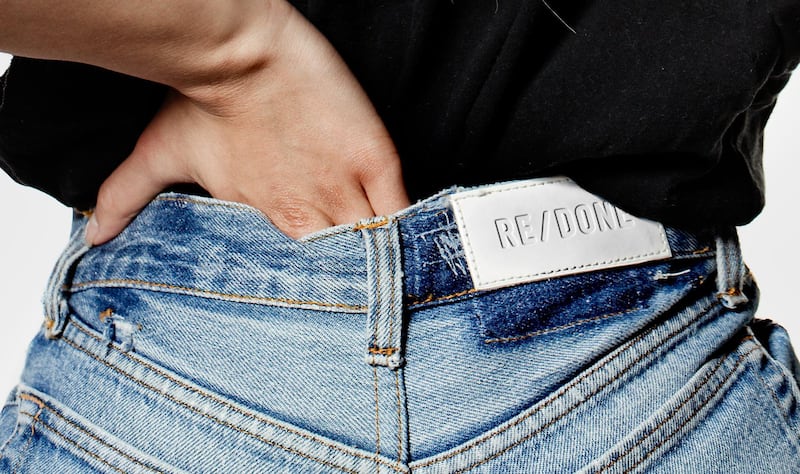"Denim is the fabric of our lives" is a tagline from the cotton industry that perfectly captures the fabric's ubiquity. Found in wardrobes around the world, denim jeans simultaneously represent rebellion, youth and a wardrobe staple. They epitomise history, tradition, hard work and authenticity.
Jeans began as workwear, a garment produced for men toiling in the mines and railroads or prospecting for gold. They were the outgrowth of a partnership between tailor Jacob Davis and dry-goods merchant Levi Strauss, and were made from a sturdy fabric originally named serge de Nimes after the city in France where the textile was produced. The fabric has a distinctive twill (diagonal) weave and is dyed with indigo, which gives it its distinctive blue colour. What made Levi Strauss’s workwear unique, however, was the addition of copper rivets on the stress points of the pockets and fly, to stop them tearing.
From workwear to symbols of rebellion, denim jeans have acted as important historical markers. Popularised by James Dean in Rebel Without a Cause, Marlon Brando in The Wild One and Elvis Presley, denim jeans became synonymous with counterculture.
In the 1960s and 1970s, denim jeans were adopted as a fashion item with the proliferation of bell-bottoms, Jesus jeans, hipsters and coloured denim made from new fabrics like polyester cotton. Everyone from Hell's Angels, punk rockers, skinheads, bikers and cowboys, to rock gods and hip-hop moguls have laid claim to denim's importance in their visual identity.
Designer denim was born when Europe and Japan entered the scene – from denim snobs’ reverence of Japanese raw selvedge denim, to the birth of designer brands such as Girbaud, Fiorucci and Gloria Vanderbilt. With Calvin Klein’s famous ad with the teenage Brooke Shields suggestively saying “nothing comes between me and my Calvin’s”, the focus shifted from utility to sex appeal.
___________________
Read more from Sass Brown:
Countering consumption with a new-look approach
In the future will we all be wearing lab-grown leather and mushroom skin?
Is the fashion industry finally becoming more inclusive?
___________________
However, the problem with denim is its environmental and human footprint. It takes approximately 5,700 litres of water to grow the 0.68 kilograms of cotton used to produce one pair of denim jeans. Cotton also uses large amounts of pesticides and the yarn is bleached with toxic chemicals, which too often cause water pollution in the developing nations where they are produced. Synthetic indigo also uses heavy metals such as cadmium, lead and mercury.
Most denim jeans receive some kind of finish to give them their famous deconstructed look, many of which use chemicals and bleach, vast amounts of water, or sanding and sandblasting, all of which have health and environmental implications. The single biggest effect, however, is actually in the consumer stage, with the average pair of jeans being washed between 50 and 75 times, requiring enormous amounts of water and energy.
As always, there are those implementing positive change. One of the foremost of these is Nudie Jeans, founded in Sweden in 2001. Born of a passion for dry, untreated denim, Nudie Jeans produces an all-organic denim line, produced in a fair and ethical way. Nudie was one of the first to popularise the concept of raw denim jeans that are meant to be worn and broken-in, with at least six months of continuous wear without laundering.
They epitomise our long-standing reverence for denim, cherishing the well-worn and the mended. These are jeans that represent the individual, and are worn as a second skin. To ensure their personalisation and longevity, the brand offers a free repair service, with expert tailors in many of their retail outlets. They also recycle used denim, feeding it back into the loop as the raw material for new products.
You might not expect the originator of denim jeans to also be at the forefront of denim innovation, but it is. Levi’s Wellthread collection represents a fundamental reinvention of the design process that incorporates sustainability in every stage of its development. Wellthread uses Water<Less denim, which constitutes a water saving of 65 per cent over the usual dye process. Almost unique to the brand is its monofibre design, with fabric, thread, pocketing and labels all made from 100 per cent cotton and designed for total recyclability. The collection is also produced in factories that invest in the well-being of the people who produce their garments.
Re/Done is an American brand that produces a luxury denim collection entirely fashioned from discarded vintage Levi’s.
It stems from the belief that vintage Levi’s denim carries, within its stitching, stories of years of wear and a history of a past life, with its travels and experiences recorded in the frayed pockets, fading and tears.
The brand takes the vintage denim jeans apart, recutting them into contemporary, fashionable styles. Re/Done manufactures its jeans in downtown Los Angeles, using water-conserving methods and no harsh chemicals. Quantities are strictly limited because each pair is hand picked, hand cut, and distinctly one of a kind. Like fine cheese, vintage denim only gets better with age.










